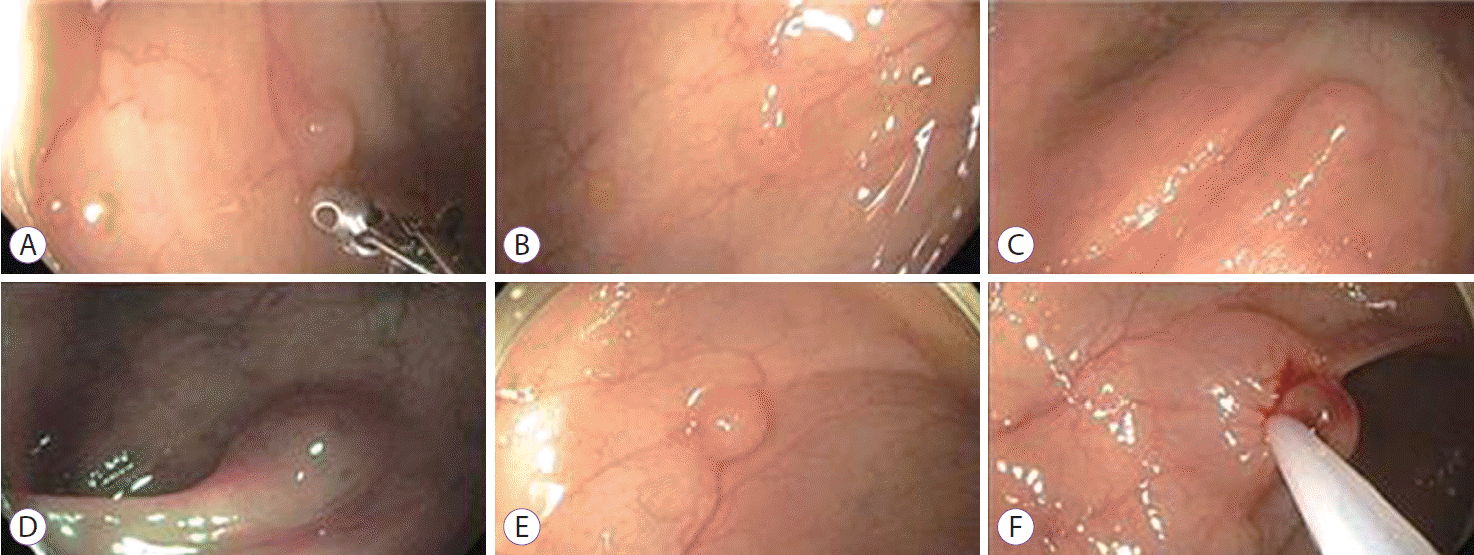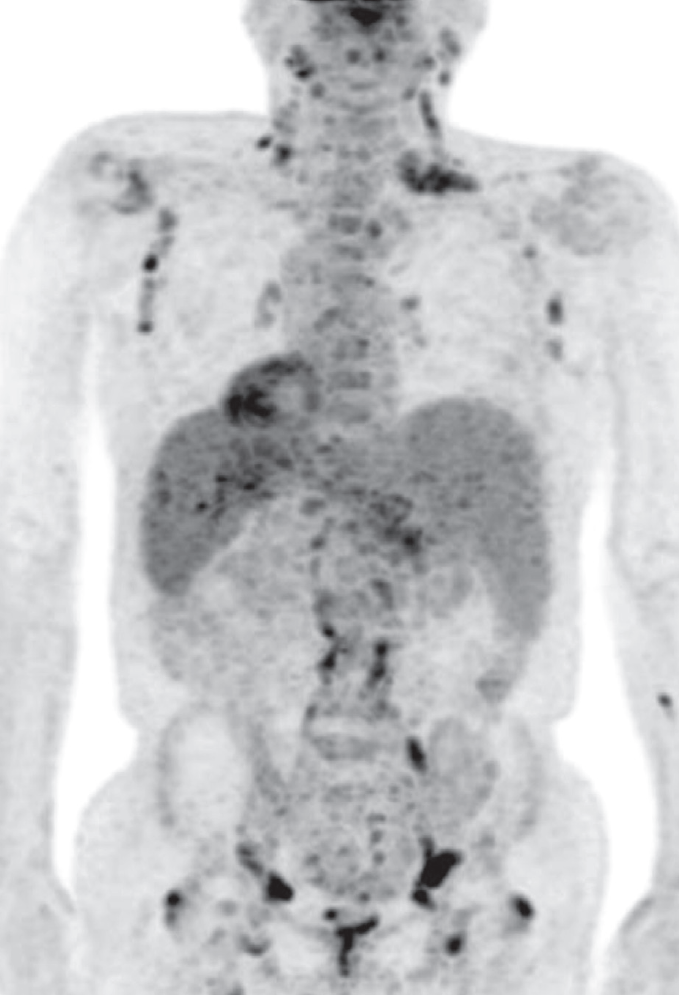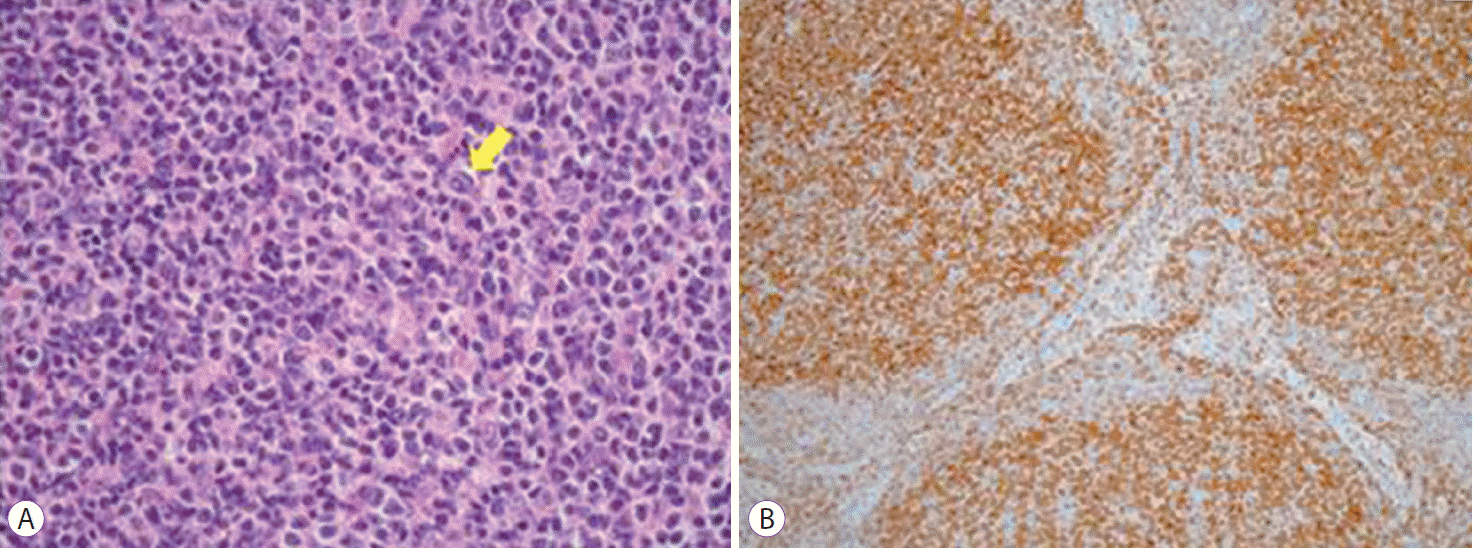INTRODUCTION
The gastrointestinal (GI) tract is the most common site of extra-nodal non-HodgkinŌĆÖs lymphoma (NHL), which accounts for 4%ŌłÆ20% of all NHLs [1]. The stomach is the most common location of GI NHL, followed by the small intestine and colon [1]. The incidence of follicular lymphomas among adults is high in Western countries but comparably small in Asia [2]. In addition, among the primary GI lymphomas, the incidence of follicular lymphoma is particularly rare, accounting for just 1%ŌłÆ6% of cases; colorectal involvement is even less frequent [3]. Colonoscopic findings of colonic lymphomas are heterogeneous; however, the appearance of low-grade B-cell lymphomas, including follicular lymphoma, mantle cell lymphoma, and mucosa-associated lymphoid tissue lymphoma, seems to be similar [3]. They all present with mucosal ulcerations, erosions, indurations, polypoid mass-like lesions, and diffuse mucosal nodularity [3-5]. Meanwhile, a certain type of colonic follicular lymphoma, which presents as isolated diminutive mucosal polyps, has not yet been reported. Herein, we report a unique case of a follicular lymphoma of the transverse colon characterized by four sessile diminutive polyps located intermittently with multiple lymph node involvement, in a 62-year-old man.
CASE REPORT
A 62-year-old man visited our hospital for a surveillance colonoscopy as part of a routine check-up. He underwent colonic polypectomy three years ago at another hospital and had not experienced hematochezia, diarrhea, abdominal pain, weight loss, or fever. Hypertension, diabetes mellitus, and stage 5 chronic kidney disease due to diabetic nephropathy were noted in his past medical story. He had been treated with hemodynamic dialysis, and the patientŌĆÖs blood pressure was 160/91 mm Hg. His body temperature was 36.3┬░C, heart rate was 73 beats per minute, respiratory rate was 20 breaths per minute, and he was mentally alert. There was neither abdominal tenderness nor rebound tenderness. Bowel sounds were normal, and the liver and spleen were not palpable. Laboratory findings were as follows: white blood cell count, 5,940 cells/╬╝L (neutrophils, 42.7%, eosinophils, 6.9%, lymphocytes, 46.6%); hemoglobin, 11.2 g/dL; platelet count, 164,000/╬╝L; aspartate aminotransferase, 13 IU/L; alanine aminotransferase, 10 IU/L; alkaline phosphatase, 81 IU/L; total bilirubin, 0.4 mg/dL; total protein, 7.7 g/dL; albumin, 4.5 g/dL; blood urea nitrogen, 24.3 mg/dL; and creatinine, 5.56 mg/dL. The serum carcinoembryonic antigen level was 2.36 ng/mL, and the serum lactate dehydrogenase level was 404 U/L, both of which were within the normal range. Colonoscopy revealed four sessile polyps, 2ŌłÆ4 mm in size, one in the hepatic flexure, two in the proximal transverse colon, and one in the distal transverse colon. The polyps had a smooth surface, without nodularity or ulceration. Narrow band imaging (NBI) without magnification was performed on one of the four colon polyps. The pit pattern of the polyp showed dark or white spots of uniform size and was identified as type 1 according to NBI international colorectal endoscopic classification [6]. We removed two of the polyps with forceps and performed en bloc endoscopic mucosal resection with a snare for the other two polyps, after injecting saline into the submucosa (Fig. 1). Upon histological examination, all resected specimens showed atypical lymphoid aggregation composed of small- to medium-sized and mainly cleaved B-lymphoid cells, which stained positively for CD20 and Bcl-2 but negatively for CD3 and cyclin D1 (Fig. 2). The labeling index of Ki-67 was 10%. These findings were highly suspicious of lymphoma. After confirming the biopsy report of colon polyps, computed tomography (CT) was performed and demonstrated multiple lymph node enlargement. Subsequently, positron emission tomography-CT was performed sequentially to confirm the degree of involvement of the follicular lymphoma. The images showed moderate splenomegaly and numerous variably sized enlarged lymph nodes on both sides of the neck, both axillae, the mediastinum, abdominal aorta, celiac trunk, hepatoduodenal ligament, gastrohepatic ligament, and both inguinal regions (Fig. 3). A bone marrow study including aspiration and trephine biopsy was performed, which showed normocellular marrow and no evidence of bone marrow involvement of malignant lymphoma.
Excisional biopsy of the lymph nodes of the left side of the neck was performed for histopathologic confirmation. On immunohistochemical staining, CD20 and Bcl-2 were positive, whereas CD3, CD5, and cyclin D1 were negative (Fig. 4). The Ki-67 labeling index was 10%. Based on these findings, the diagnosis of grade 1 follicular lymphoma with a predominantly follicular pattern was made. The tumor was stage IIIA according to the Ann Arbor staging system [7]. The patient received five courses of combination chemotherapy, consisting of cyclophosphamide, vincristine, prednisone, and rituximab (R-CVP), which led to complete remission. Since then, maintenance therapy with rituximab has been initiated, and no recurrence has been reported for approximately 21 months.
DISCUSSION
NHLs of the GI tract account for between 30% and 70% of extranodal lymphomas and present with different clinical and pathological characteristics [2]. The incidence of primary GI lymphoma is very rare, representing only 1%ŌłÆ4% of all GI malignancies [8]. The most common sites of primary GI lymphoma are the stomach, small intestine, and ileocecal region [9].
Follicular lymphoma is the second most common subtype of NHL in Western countries, and it typically arises in the lymph nodes with spleen, liver, and bone marrow involvement [8,10]. It can also develop in the GI tract. However, follicular lymphoma of the GI tract constitutes only 1%ŌłÆ3% of all primary GI lymphomas [4]. Colorectal follicular lymphoma is rarer than that found in the small intestine, especially the duodenum [3]. One study on patients with primary intestinal follicular lymphoma revealed that the most frequent site was the second portion of the duodenum (81%) followed by the jejunum (40%), whereas the rate of colon involvement was just 1% [11]. In addition, there are few reports on colorectal follicular lymphoma in Korea [12,13]. The most common symptoms of colorectal lymphoma are abdominal pain, changes in bowel habits, GI bleeding, and the presence of an abdominal mass; in particular, abdominal pain is more common for B-cell lymphoma, including follicular lymphoma [5]. However, several cases have been discovered during screening without specific symptoms [9,12]. Our patient had no symptoms, and the lesions were found by chance during colonoscopic surveillance.
Several studies have reported the colonoscopic findings of colorectal lymphomas and divided them into three types [14] and five types [15]. Meanwhile, a recent study categorized colonoscopic colorectal follicular lymphoma lesions into three subgroups: papular, polypoid, and flat elevated types [3]. In our case, however, four sessile diminutive polyps were located some distance from each other with smooth margins, no ulceration, and no nodularity. Our findings did not correlate with any of three subtypes mentioned above, and such a case has not yet been reported in Korea. In one study, 78 patients were diagnosed with primary colorectal lymphoma during colonoscopy, and none of them had characteristics that resembled those of our case [5]. There are only two reports of primary colorectal follicular lymphoma in Korea; one case showed two polyps less than 4 mm in size that were sub-epithelial lesions, whereas the other case showed multiple 10ŌłÆ20-mm mucosal elevated lesions. Both of those previous cases were located in the rectum and not the colon [12,13].
Most GI follicular lymphomas express CD20, Bcl-2, Bcl-6, and CD10, but do not express CD3, CD5, CD23, CD43, or cyclin D1 [2,4]. The Ann Arbor system is used for the staging of primary GI lymphoma [7]. Our patientŌĆÖs tumor was diagnosed as stage IIIA owing to lymph node involvement in the left side of the neck, which was confirmed by excisional biopsy. Notably, previously published Korean cases did not report any infiltration of the liver, spleen, bone marrow, or lymph nodes as compared with our case [12,13].
The management of GI follicular lymphoma is not well established because of its rarity. However, as the disease course of GI follicular lymphoma is similar to that of nodal follicular lymphoma, a watch-and-wait strategy or radiation therapy can be applied in the case of limited stage (Ann Arbor stage I or II) follicular lymphoma, depending on patient-specific factors. The treatment of patients with advanced stage (Ann Arbor stage III or IV) follicular lymphoma depends on the presence or absence of symptoms, tumor burden, age, comorbidities, and the overall goals of therapy. When symptoms are present or the tumor burden is high, conventional chemotherapy, such as rituximab with cyclophosphamide, doxorubicin, vincristine, and prednisone or R-CVP can improve outcomes, including overall survival [16]. In addition, maintenance rituximab strategies can improve progression-free survival [16,17].
In the meantime, the ŌĆ£resect and discard strategyŌĆØ is suggested for the colonoscopic management of diminutive colorectal polyps, which may save time and cost and decrease the risk to patients [18]. According to this strategy, the histologic type of the polyp is predicted in vivo by an appropriate endoscopic method, and certain post-polypectomy pathologic specimens are discarded [19]. This approach is based on data showing a very low prevalence of advanced histology in diminutive polyps [20]. If we had applied this strategy to our case, in which no malignant features were present in the mucosa upon colonoscopic examination, the diagnosis of follicular lymphoma could not have been made at an appropriate time, and proper management would not have been achieved. Therefore, we insist that the pathologic confirmation of diminutive polyps is required.
In this report, we present a unique case of follicular lymphoma of the transverse colon characterized by diminutive sessile polyps located intermittently and multiple lymph node involvement.











